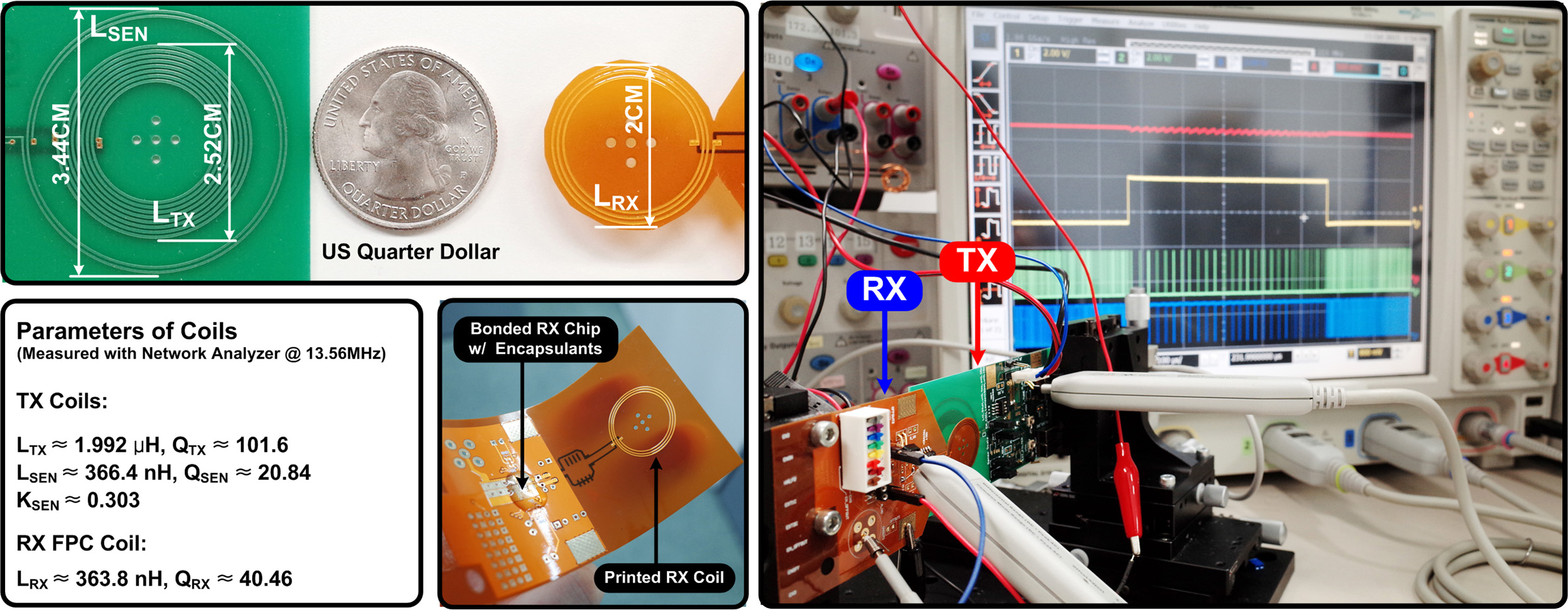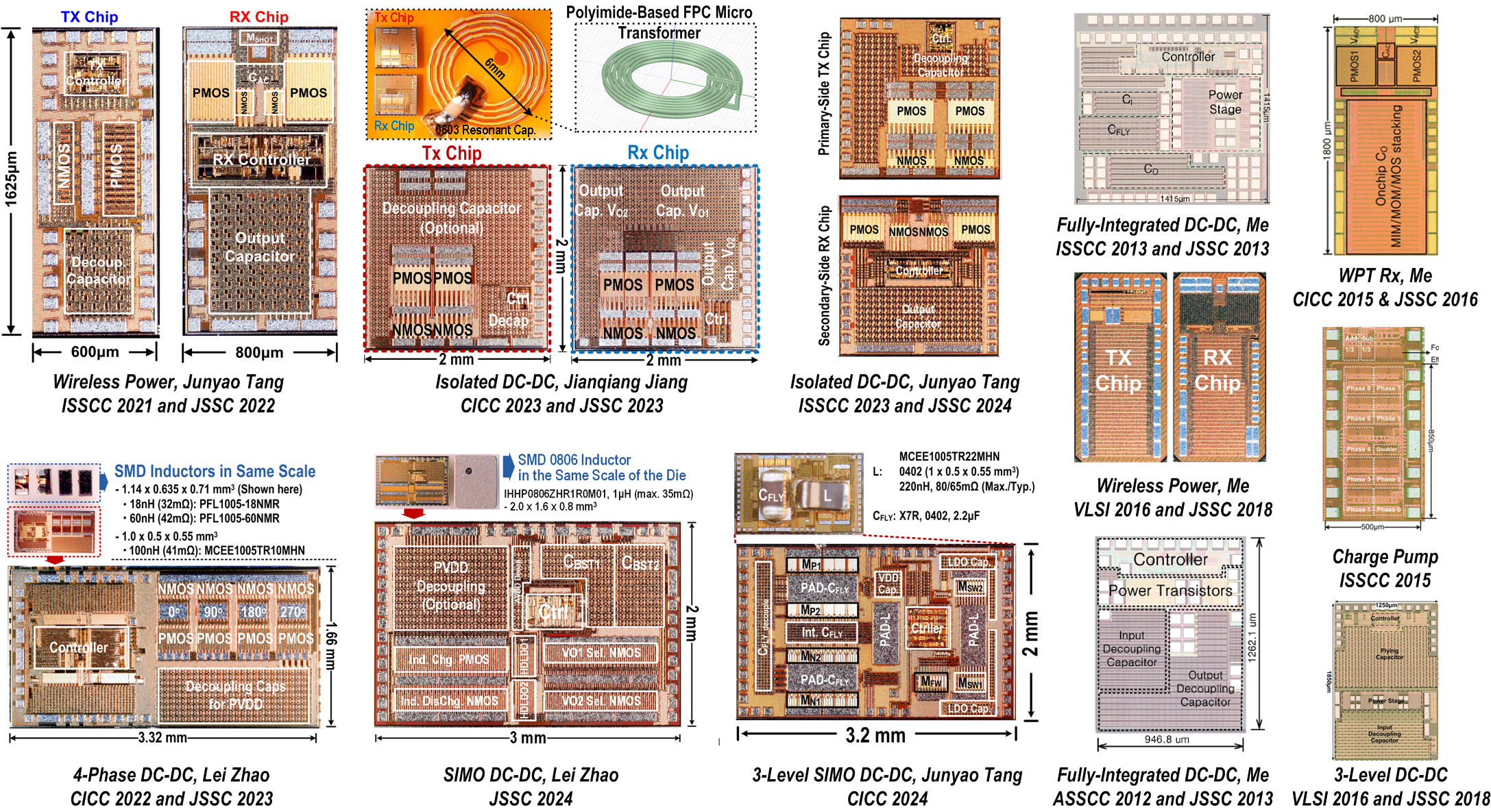Ongoing Research Projects:
1. Wireless Power Transfer (WPT) Systems. In this project, we develop efficient WPT system to transmit power wirelessly to support applications with different power levels, from Watt-level for smart-phone/laptop charger, to miliWatt-level for biomedical implants. Students will be designing the power transmitter, wireless power link (coils for inductive coupling), and power receiver. This project is focusing on improving the performance of WPT systems, including the efficiency, transmission distance, power capacity, dynamic performance during transient events, as well as reducing the form-factor and cost.

Students involved: Junyao Tang (PhD), Zhenhao Li (PhD Student), Shuo Xie (MS), Hoang Dang (BS).
2. Isolated DC-DC Converters. Isolators are widely used to isolate different voltage domains while being able to transmit signal, data and power across the isolated barriers or drive transistors in floating domains, with ensured device and human safety and signal integrity. Traditional transformer-based galvanically isolated voltage regulators (GIVRs) can deliver Watts of power with 70-80% efficiency. However, the use of bulky transformers becomes the primary bottleneck to further reduce the form-factor to package level. Recently, emerging research has led to developing in-package GIVRs with miniature transformers in special processes, however, with significant compromises in power capacity and efficiency (10-50% from designs in the literature) compared to traditional designs. The special processes used are not widely available thus more expensive. Our designs are focusing on improving the power efficiency for package-level integrated GIVRs, and at the same time achieving fast dynamic response and without using special processes.

Students involved: Junyao Tang (PhD); Jianqiang Jiang (PhD Student).
3. High-Frequency Fully-Integrated Voltage Regulators (FIVRs). Voltage regulators are fundamental in any electronics to bridge the gap between: the unregulated single voltage from the sources (e.g., the Li-ion battery, with which the actual output voltage varies from 2.8 to 4.2 V depending on the condition of the battery), and the multiple well-regulated voltages needed in different building blocks in a system (e.g., CPU, Memory, I/Os, data converters, sensors, they need different voltages to operate, and the voltage has to be accurate). This project is to design FIVRs with all the components, including the passive inductors and capacitors, integrated at the chip or package level. They will be switching at a relatively high frequency (e.g. 100 MHz). This project is focusing on improving the performance of FIVRs, including the power efficiency, capacity, load-/reference-tracking speed, reliability, voltage and load range, as well as reducing the form-factor and cost (hence higher power density).

Students involved: Lei Zhao (PhD Student); Julián Canabal-Rodríguez and Samuel Rosette (APEX-E Undergraduate Students).
4. Single-Inductor Multiple Output (SIMO) Voltage Regulators. Multiple voltage supplies are common in almost any electronic device to support various blocks in the system or SoCs. High efficiency inductive switchers are widely used to provide these supplies, however, the power inductors are bulky and expensive. The beauty of SIMO converters is that it can increase the number of voltage supplies without introducing extra inductors, which significantly reduces the BOM (bill of materials), hence the cost, form-factor and system design complexity. This project is focusing on suppressing voltage droops during large and fast load transients, and improve the power capacity of SIMO converters.

Student involved: Lei Zhao (PhD Student), Junyao Tang (PhD)
5. Gallium Nitride (GaN) Based Power Converter Designs. We believe that wide-bandgap semiconductors, such as GaN devices, will lead to a revolution in power electronics with much higher efficiency due to their superior material properties. So our group will be developing new circuit and system techniques to achieve high efficiency, high power density, robust, and fast power management circuit designs.

Student involved: Muhammad Rizwan Khan (PhD Student), Si Yuan Sim (MS).
6. Cap-less LDOs for RF Applications.
Student involved: Kejia Wang (PhD Student).
7. Laser Diode and Photodiode Drivers for LiDAR Systems.
Student involved: Xuan Sun (PhD Student), Wenshuo Zhu (PhD Student).
Chip Gallery

Future Research Projects:
Energy harvesting for wireless sensors, High-power kW-level WPT system for electric vehicles, and more.